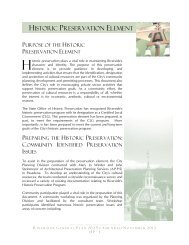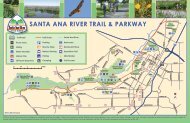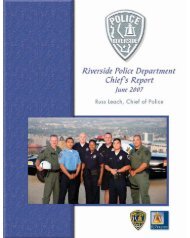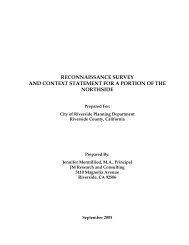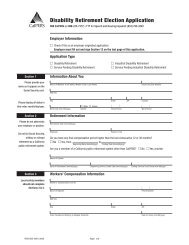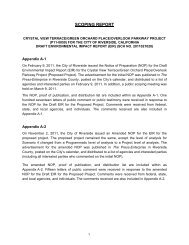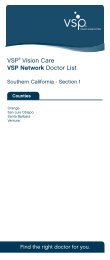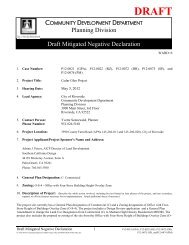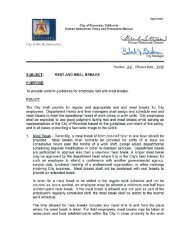Airport Master Plan - City of Riverside
Airport Master Plan - City of Riverside
Airport Master Plan - City of Riverside
You also want an ePaper? Increase the reach of your titles
YUMPU automatically turns print PDFs into web optimized ePapers that Google loves.
TABLE 3G<br />
Runway Protection Zones<br />
<strong>Riverside</strong> <strong>Airport</strong><br />
Runway 9 Runway 27 Runway 16-34<br />
Approach Visibility Minimum 1/2 Mile 1 Mile 1 Mile 3/4 Mile 1 Mile<br />
<strong>Airport</strong> Reference Code B-II C-II B-II C-II B/C-II B-I<br />
Inner Width 1,000 1,000 500 500 1,000 250<br />
Outer Width 1,750 1,750 700 1,010 1,510 450<br />
Length 2,500 2,500 1,000 1,700 1,700 1,000<br />
BOLD: Existing RPZ dimensions<br />
Source: FAA AC 150/5300-13, <strong>Airport</strong> Design, Change 11<br />
RUNWAYS<br />
The adequacy <strong>of</strong> the existing runway<br />
system at <strong>Riverside</strong> <strong>Airport</strong> has been<br />
analyzed from a number <strong>of</strong> perspectives,<br />
including runway orientation,<br />
runway length, pavement strength,<br />
width, and adherence to safety area<br />
standards. From this information, requirements<br />
for runway improvements<br />
were determined for the airport.<br />
should be made available when the<br />
primary runway orientation provides<br />
for less than 95 percent wind coverage<br />
for specific crosswind components.<br />
The 95 percent wind coverage is computed<br />
on the basis <strong>of</strong> the crosswind<br />
component not exceeding 10.5 knots<br />
(12 mph) for ARCs A-I and B-I; 13<br />
knots (15 mph) for ARCs A-II and B-<br />
II; and 16 knots (18 mph) for ARC C-I<br />
through D-II.<br />
Runway Orientation<br />
The airport is served by two intersecting<br />
runways. Runway 9-27 is oriented<br />
in an east-to-west manner while Runway<br />
16-34 is oriented in a north-south<br />
manner. For the operational safety<br />
and efficiency <strong>of</strong> an airport, it is desirable<br />
for the primary runway to be<br />
oriented as closely as possible to the<br />
direction <strong>of</strong> the prevailing wind. This<br />
reduces the impact <strong>of</strong> wind flowing<br />
perpendicular to the direction <strong>of</strong> travel<br />
<strong>of</strong> an aircraft that is landing or taking<br />
<strong>of</strong>f (defined as a crosswind).<br />
FAA Advisory Circular 150/5300-13,<br />
<strong>Airport</strong> Design, Change 11, recommends<br />
that a crosswind runway<br />
3-16<br />
All-weather wind data specific to <strong>Riverside</strong><br />
<strong>Airport</strong> was obtained from National<br />
Oceanic and Atmospheric Administration<br />
(NOAA) for the years<br />
from 1997 to 2006. The wind data is<br />
depicted on Exhibit 3E. Runway 9-27<br />
provides 96.15 percent wind coverage<br />
for 10.5 knot crosswinds and 97.16<br />
percent coverage at 13 knots. Runway<br />
16-34 provides 94.45 percent wind<br />
coverage at 10.5 knots and 97.04 percent<br />
coverage at 13 knots.<br />
The two-runway system at <strong>Riverside</strong><br />
<strong>Airport</strong> provides 99.55 percent coverage<br />
for 10.5 knot crosswinds and nearly<br />
100 percent coverage for other<br />
crosswind components. There is no<br />
need to consider additional runway<br />
orientations at <strong>Riverside</strong> <strong>Airport</strong>.



